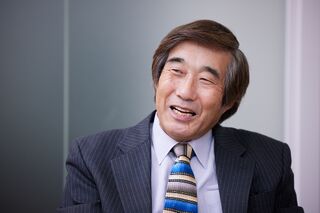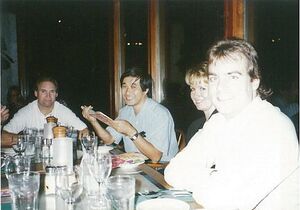Difference between revisions of "Hiroshi Yagi"
From Sega Retro
m (→Early years) |
m |
||
| Line 8: | Line 8: | ||
| education=[[wikipedia:Nihon University|Nihon University, College of Science and Technology]] | | education=[[wikipedia:Nihon University|Nihon University, College of Science and Technology]] | ||
}} | }} | ||
| − | '''{{PAGENAME}}''' (矢木 博) is a Japanese engineer and developer. One of the most prolific and long-standing engineers for [[Sega]], he has overseen and led the development of numerous successful arcade boards and other hardware during his two periods at the company. | + | '''{{PAGENAME}}''' (矢木 博) is a Japanese engineer and developer. One of the most prolific and long-standing engineers for [[Sega]], he has overseen and led the development of numerous successful arcade boards and other hardware during his two periods at the company.{{fileref|Sega_Arcade_History_JP_EnterBrain_Book-1.pdf|page=184}} |
Since the 2010s, Yagi has officially retired from most of his duties and instead focused on database development and windsurfing, however has continued work at Sega as a consultant on occasion. | Since the 2010s, Yagi has officially retired from most of his duties and instead focused on database development and windsurfing, however has continued work at Sega as a consultant on occasion. | ||
Revision as of 18:44, 18 May 2022

|
| Hiroshi Yagi |
|---|
| Place of birth: Ota City, Tokyo, Japan |
| Date of birth: 1950 (age 73-74) |
| Company(ies): Sega of Japan |
| Role(s): Engineer |
| Education: Nihon University, College of Science and Technology |
Hiroshi Yagi (矢木 博) is a Japanese engineer and developer. One of the most prolific and long-standing engineers for Sega, he has overseen and led the development of numerous successful arcade boards and other hardware during his two periods at the company.[1]
Since the 2010s, Yagi has officially retired from most of his duties and instead focused on database development and windsurfing, however has continued work at Sega as a consultant on occasion.
Contents
Career
Early years

Born during 1950 in Ota, Tokyo and educated in science and technology at Nihon University, Hiroshi Yagi first joined Sega in 1975.[2] His career of choice at electrical manufacturers, a profession of which he had been interested in since his youth, was uncertain due to the 1973 oil crisis; Yagi ultimately applied for work at Sega due to its headquarters' close proximity to his home.[3] Initially assigned to cabinet engineering in the Sega Production and Engineering Department, his first notable work was Rodeo, one of the earliest pinball tables to rely on solid state technology instead of electromechanics. Yagi chose the Intel 4040 processor used for its score display and sound control.[3] After this, he moved into work on in-house arcade hardware.[3]
By 1980, Yagi had left Sega for Honda, joining the company's institute of technology to design graphics instead of games - a decision motivated by a business trip to Gremlin Industries and his enjoyment of Head-On.[3] However, disappointed with their R&D capabilities and unable to fulfil his graphic design intents, this change of career was short-lived, and with the approval of former mentor Hideki Sato, he re-joined Sega in 1983.[3] Upon his return, he continued with arcade boards, going on to engineer System 2, the Sega OutRun hardware, its X and Y Board successors, and hardware used in horse racing medal games.[4] As a result of Sega's superior development environment, Yagi was also now able to work in graphic design on the side.[3]
Game Gear, return to arcades

The advent of Nintendo's Game Boy, a black and white handheld system, led to Sega beginning development of its own color handheld in 1989.[2] Yagi played an instrumental role in developing what would eventually become the Game Gear, taking inspiration from the design of numerous streamlined handheld devices of the time.[3] His experience on medal games using miniaturized boards aided his efforts in reducing the size of its internal hardware, with specific focus on creating a downsized but durable product.[2] Though subsequently less successful than the device it was conceived to compete with and better, Yagi was nonetheless proud of the meticulous planning that went into its development.[3]
Following the Game Gear's completion, Yagi moved back into arcade board R&D, his experience now allowing him to become the head of its dedicated department in AM4.[3] After contributing to the final stages of the Model 1's development, he spearheaded collaboration with General Electric to create the Model 2, the first Sega arcade board made in conjunction with another company.[3] Yagi travelled to the US several times to study GE's technology and exchange ideas with its personnel; despite the latter's inexperience with ICs and language barrier,[4] access to its advanced 3DCG technology led to his team perfecting the Model 2 and later Model 3's design, with both using the most powerful hardware available on the arcade market.[3]
Later years
With the exception of the Hikaru, all Sega arcade hardware developed after the Model 3 was to be based primarily on pre-existent technology used in consoles, saving cost for the company amidst its financial struggles and a continued decline in the arcade industry.[3] Though still overseeing the development of the NAOMI, NAOMI 2, Triforce, and Chihiro, these saw Yagi significantly less technically involved than before, with much of the technology already in place and requiring little engineering.[3] The 2000s also saw him contribute to the development of the ALL.Net network[3] and Let's Go Golf golfing simulator.[2]
At the age of 60, Yagi officially retired from Sega in 2010;[3] despite this, he continued to work with the company on numerous occasions throughout the decade as a senior consultant on further arcade projects.[5] More recently, he has been focused on database development and windsurfing. To commemorate the release of the Game Gear Micro, Yagi has been one of several former Sega personnel interviewed in Fumio Kurokawa's "Video Game Storytellers" series for 4Gamer.net.
Production history
- Rodeo (1976)
- Super Derby (1984)
- System 2 (1985)
- Sega OutRun hardware (1986)
- X Board (1987)
- Y Board (1988)
- World Derby (1988)
- Sega Game Gear (1990)
- Sega Model 2 (1993)
- Sega Model 3 (1996)
- Sega NAOMI (1998)
- Sega NAOMI 2 (2000)
- Chihiro (2003)
- ALL.Net (2004)
- Let's Go Golf (2008)
Games
- Rodeo (Pinball (solid state); 1976)
- World Derby (Medal game; 1988) — Mechanical Designer
- Royal Ascot (Medal game; 1991)
- Let's Go Golf! (Mid-size attraction; ?)
Music
- Sega System 16 Complete Soundtrack Vol. 1 (CD; 2010) — Commentary[6]
Hardware
- Sega System 2 (Arcade; 1985)
- Sega OutRun hardware (Arcade; 1986)
- Sega X Board (Arcade; 1987)
- Sega Y Board (Arcade; 1988)
- Sega Game Gear (Game Gear; 1990)
- Sega Model 1 (Arcade; 1992) — Bug Fixing
- Sega NAOMI (Arcade; 1998)
- Sega NAOMI 2 (Arcade; 2001)
- Triforce (Arcade; 2002)
- Sega Chihiro (Arcade; 2002)
- Sega Lindbergh (Arcade; 2005)
- Sega Model 2 (Arcade; 1994)
- Sega Model 3 (Arcade; 1996)
- REC Check Golf (2012)
Photographs
- Main article: Photos of Hiroshi Yagi
External links
- Video Game Storytellers Part 21: Game Gear pursuing ideals at the forefront of the times... Mr. Hiroshi Yagi's pride in the hardware of Sega Video article by Fumio Kurokawa at 4Gamer.net (Japanese)
- "SEGA CONSUMER 30th ANNIVERSARY BOOK" Game Gear Edition / Mr. Yagi, the "creator", tells the secret story of the development! article at famitsu.com (Japanese)
- "GAME ON" Talk Event "Telling the History of Sega Hard" Report talk featuring Yagi at GAME Watch (Japanese)
References
- ↑ File:Sega_Arcade_History_JP_EnterBrain_Book-1.pdf, page 184
- ↑ 2.0 2.1 2.2 2.3 https://www.famitsu.com/news/201308/13038313.html (Wayback Machine: 2013-09-14 06:01)
- ↑ 3.00 3.01 3.02 3.03 3.04 3.05 3.06 3.07 3.08 3.09 3.10 3.11 3.12 3.13 3.14 https://www.4gamer.net/games/999/G999905/20210126043/ (Wayback Machine: 2021-02-05 15:00)
- ↑ 4.0 4.1 https://game.watch.impress.co.jp/docs/news/758667.html (Wayback Machine: 2016-06-05 09:17)
- ↑ http://3droundabout.com/2012/01/5950/sega-and-3d-international-create-3d-arcade-game-system.html (Wayback Machine: 2012-01-20 18:21)
- ↑ File:SS16CSTV1 Album JP Booklet.pdf, page 12